ABC Company Staff Demotivation: Causes and Solutions Report
VerifiedAdded on 2023/04/04
|10
|1964
|338
Report
AI Summary
This report, prepared for BUS1007 Organisational Behaviour, addresses the critical issue of employee demotivation within ABC Company, an advertising firm facing challenges of high absenteeism, mental health issues, and poor performance. The report, acting as a consultation for the company, begins by identifying five key causes of demotivation, including lack of job security, a hostile work environment, lack of recognition, limited development opportunities, and excessive job stress. Drawing on organisational behaviour theories such as Maslow's Hierarchy of Needs, Adams' Equity Theory, and Herzberg's Two-Factor Theory, the report proposes five strategies to improve staff motivation. These include providing job security, fostering a positive workplace environment, implementing rewards and incentives, offering career and personal development opportunities, and establishing flexible working conditions. The conclusion emphasizes that by implementing these strategies, ABC Company can create a positive organisational culture where employees are motivated to improve their performance and achieve their targets, ultimately contributing to the company's success. The report provides a comprehensive framework for addressing and mitigating the negative impacts of demotivation, helping organisations to cultivate a more engaged and productive workforce.
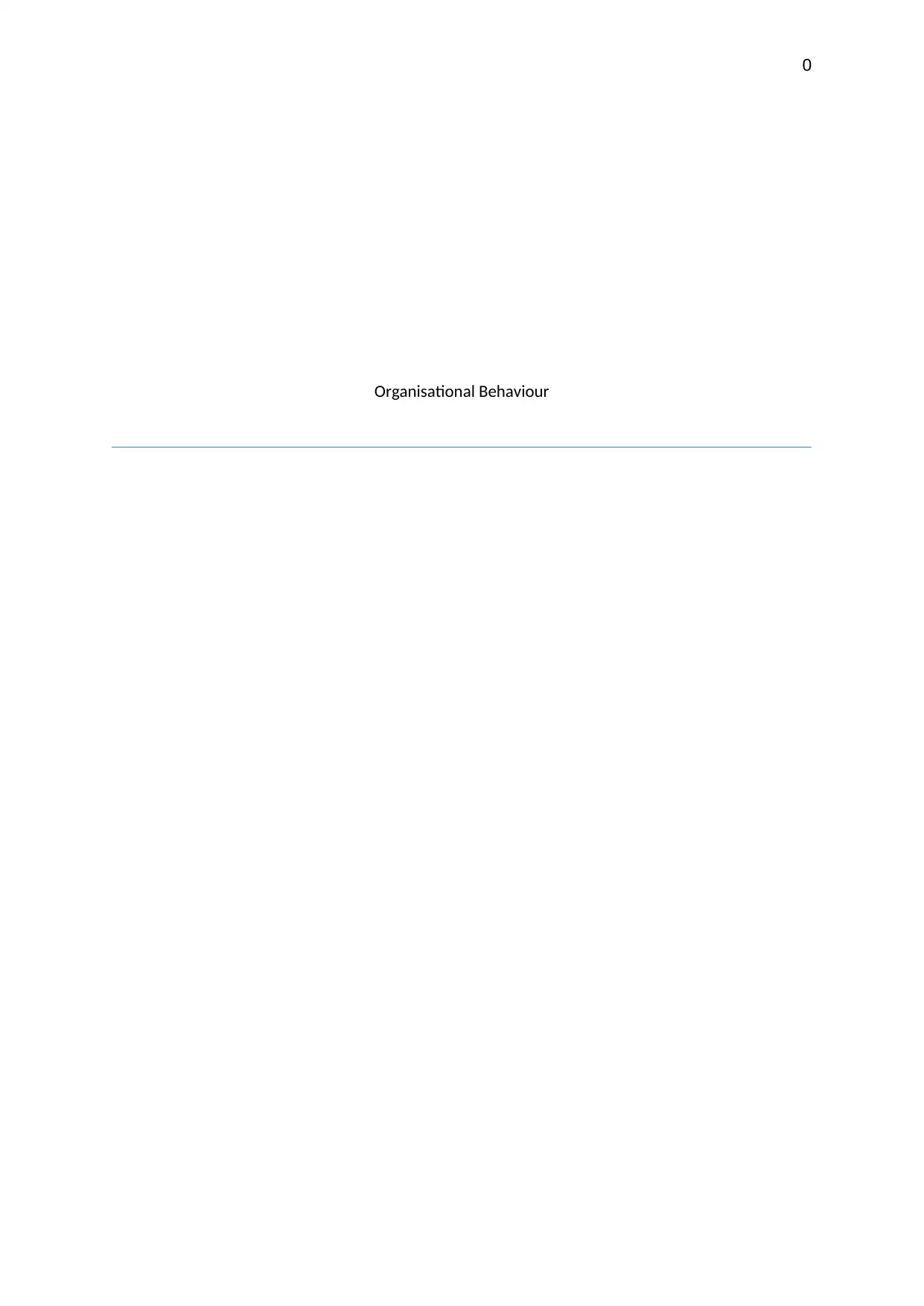
0
Organisational Behaviour
Organisational Behaviour
Paraphrase This Document
Need a fresh take? Get an instant paraphrase of this document with our AI Paraphraser
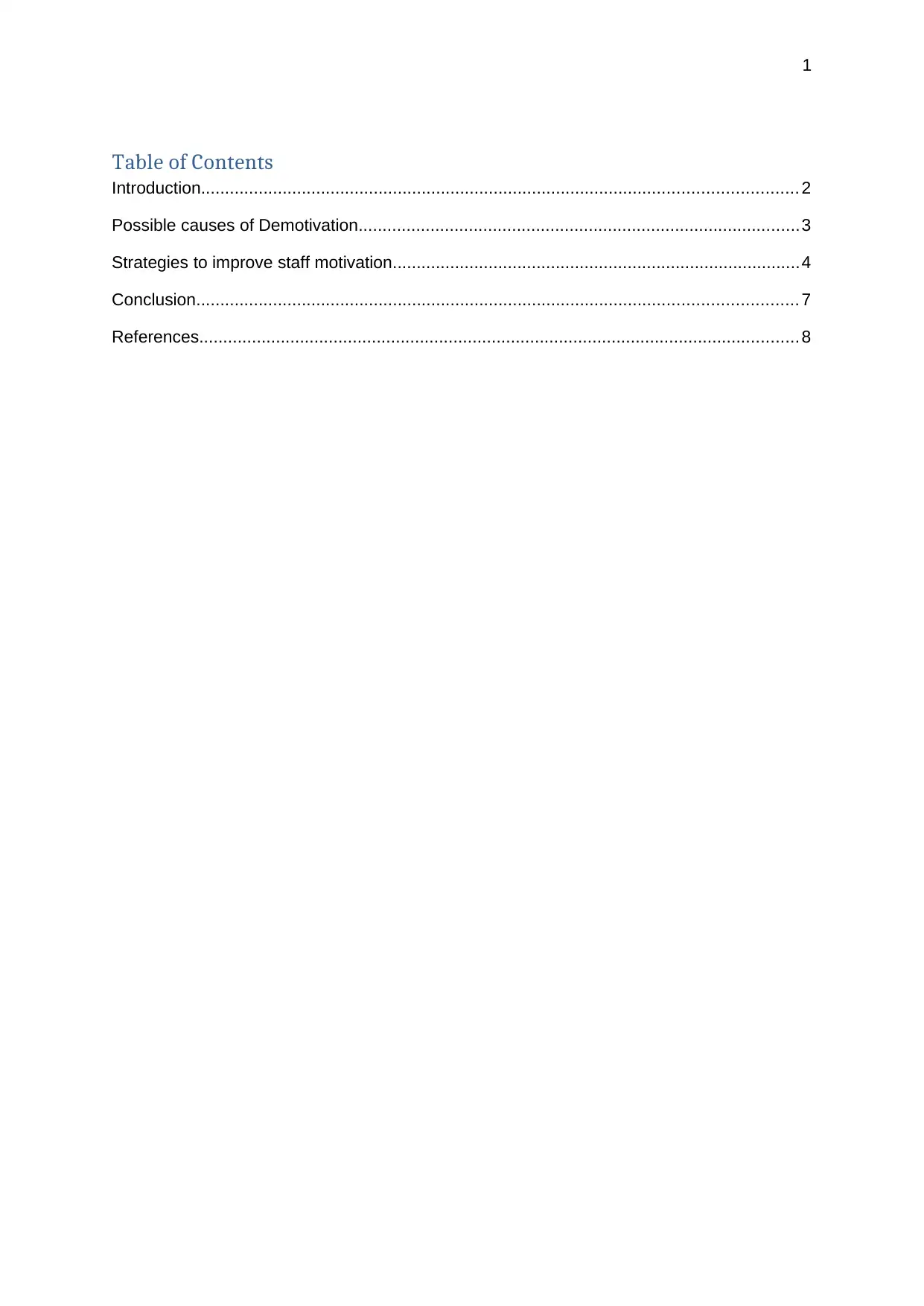
1
Table of Contents
Introduction............................................................................................................................ 2
Possible causes of Demotivation............................................................................................3
Strategies to improve staff motivation.....................................................................................4
Conclusion............................................................................................................................. 7
References............................................................................................................................. 8
Table of Contents
Introduction............................................................................................................................ 2
Possible causes of Demotivation............................................................................................3
Strategies to improve staff motivation.....................................................................................4
Conclusion............................................................................................................................. 7
References............................................................................................................................. 8
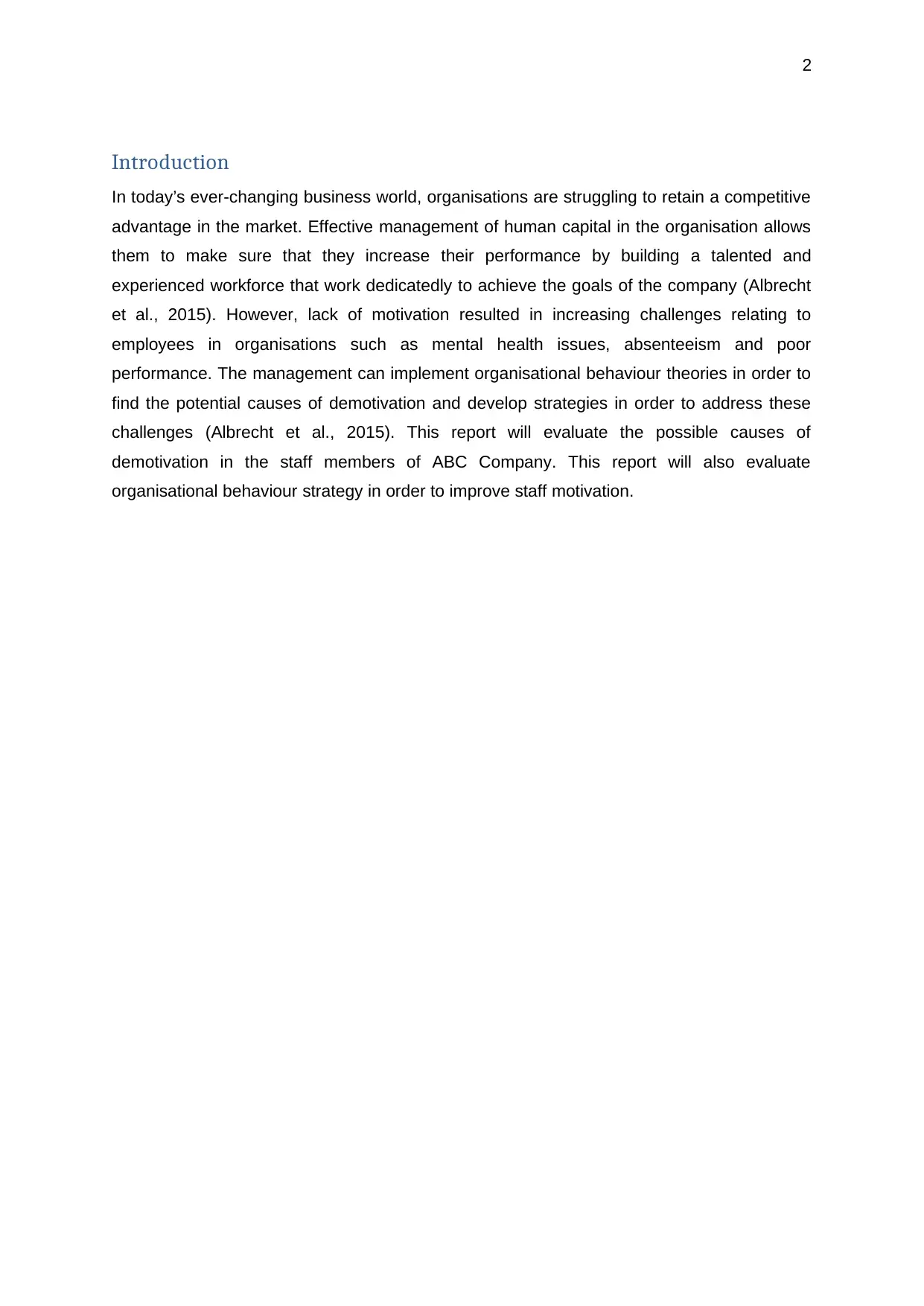
2
Introduction
In today’s ever-changing business world, organisations are struggling to retain a competitive
advantage in the market. Effective management of human capital in the organisation allows
them to make sure that they increase their performance by building a talented and
experienced workforce that work dedicatedly to achieve the goals of the company (Albrecht
et al., 2015). However, lack of motivation resulted in increasing challenges relating to
employees in organisations such as mental health issues, absenteeism and poor
performance. The management can implement organisational behaviour theories in order to
find the potential causes of demotivation and develop strategies in order to address these
challenges (Albrecht et al., 2015). This report will evaluate the possible causes of
demotivation in the staff members of ABC Company. This report will also evaluate
organisational behaviour strategy in order to improve staff motivation.
Introduction
In today’s ever-changing business world, organisations are struggling to retain a competitive
advantage in the market. Effective management of human capital in the organisation allows
them to make sure that they increase their performance by building a talented and
experienced workforce that work dedicatedly to achieve the goals of the company (Albrecht
et al., 2015). However, lack of motivation resulted in increasing challenges relating to
employees in organisations such as mental health issues, absenteeism and poor
performance. The management can implement organisational behaviour theories in order to
find the potential causes of demotivation and develop strategies in order to address these
challenges (Albrecht et al., 2015). This report will evaluate the possible causes of
demotivation in the staff members of ABC Company. This report will also evaluate
organisational behaviour strategy in order to improve staff motivation.
⊘ This is a preview!⊘
Do you want full access?
Subscribe today to unlock all pages.

Trusted by 1+ million students worldwide
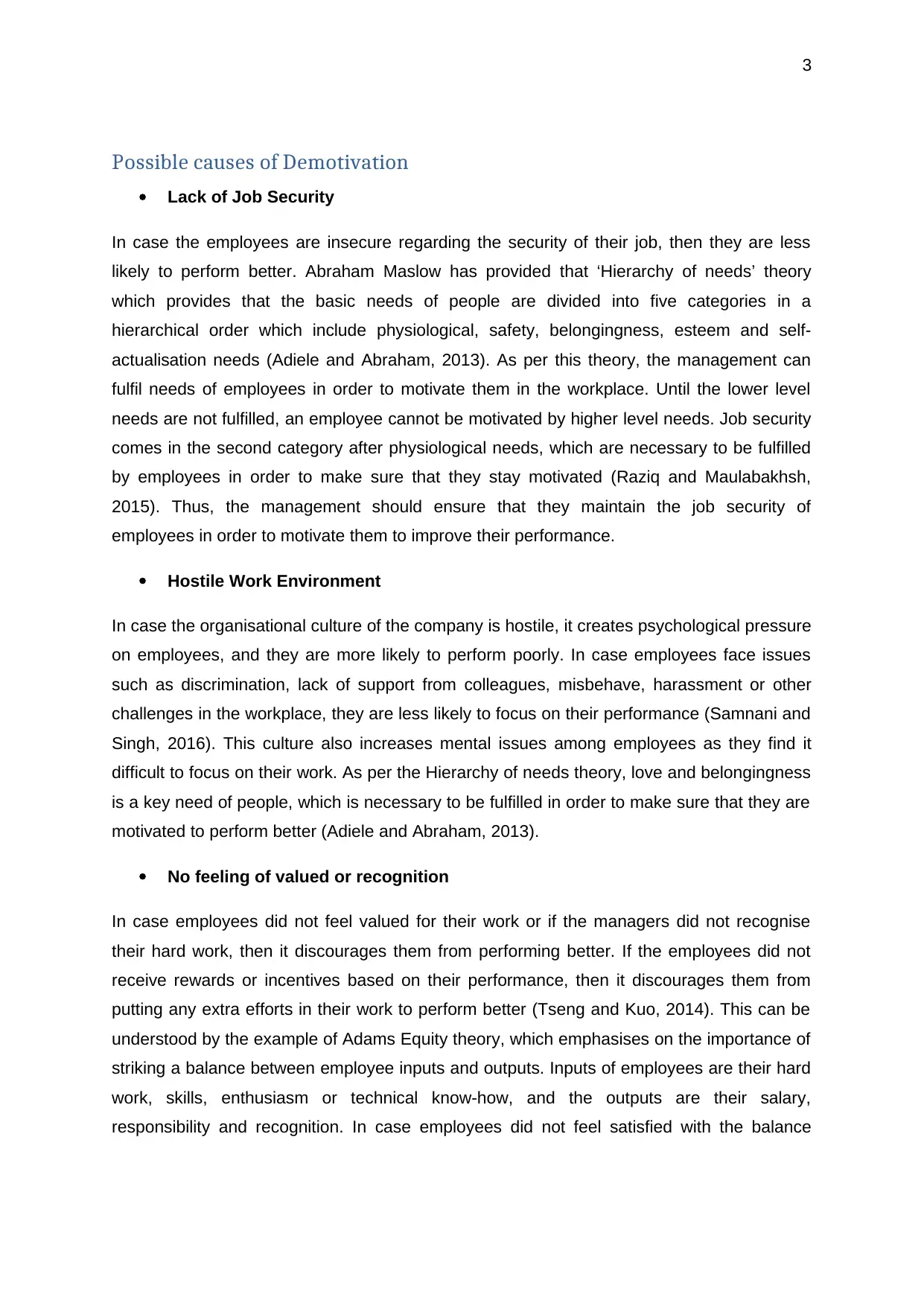
3
Possible causes of Demotivation
Lack of Job Security
In case the employees are insecure regarding the security of their job, then they are less
likely to perform better. Abraham Maslow has provided that ‘Hierarchy of needs’ theory
which provides that the basic needs of people are divided into five categories in a
hierarchical order which include physiological, safety, belongingness, esteem and self-
actualisation needs (Adiele and Abraham, 2013). As per this theory, the management can
fulfil needs of employees in order to motivate them in the workplace. Until the lower level
needs are not fulfilled, an employee cannot be motivated by higher level needs. Job security
comes in the second category after physiological needs, which are necessary to be fulfilled
by employees in order to make sure that they stay motivated (Raziq and Maulabakhsh,
2015). Thus, the management should ensure that they maintain the job security of
employees in order to motivate them to improve their performance.
Hostile Work Environment
In case the organisational culture of the company is hostile, it creates psychological pressure
on employees, and they are more likely to perform poorly. In case employees face issues
such as discrimination, lack of support from colleagues, misbehave, harassment or other
challenges in the workplace, they are less likely to focus on their performance (Samnani and
Singh, 2016). This culture also increases mental issues among employees as they find it
difficult to focus on their work. As per the Hierarchy of needs theory, love and belongingness
is a key need of people, which is necessary to be fulfilled in order to make sure that they are
motivated to perform better (Adiele and Abraham, 2013).
No feeling of valued or recognition
In case employees did not feel valued for their work or if the managers did not recognise
their hard work, then it discourages them from performing better. If the employees did not
receive rewards or incentives based on their performance, then it discourages them from
putting any extra efforts in their work to perform better (Tseng and Kuo, 2014). This can be
understood by the example of Adams Equity theory, which emphasises on the importance of
striking a balance between employee inputs and outputs. Inputs of employees are their hard
work, skills, enthusiasm or technical know-how, and the outputs are their salary,
responsibility and recognition. In case employees did not feel satisfied with the balance
Possible causes of Demotivation
Lack of Job Security
In case the employees are insecure regarding the security of their job, then they are less
likely to perform better. Abraham Maslow has provided that ‘Hierarchy of needs’ theory
which provides that the basic needs of people are divided into five categories in a
hierarchical order which include physiological, safety, belongingness, esteem and self-
actualisation needs (Adiele and Abraham, 2013). As per this theory, the management can
fulfil needs of employees in order to motivate them in the workplace. Until the lower level
needs are not fulfilled, an employee cannot be motivated by higher level needs. Job security
comes in the second category after physiological needs, which are necessary to be fulfilled
by employees in order to make sure that they stay motivated (Raziq and Maulabakhsh,
2015). Thus, the management should ensure that they maintain the job security of
employees in order to motivate them to improve their performance.
Hostile Work Environment
In case the organisational culture of the company is hostile, it creates psychological pressure
on employees, and they are more likely to perform poorly. In case employees face issues
such as discrimination, lack of support from colleagues, misbehave, harassment or other
challenges in the workplace, they are less likely to focus on their performance (Samnani and
Singh, 2016). This culture also increases mental issues among employees as they find it
difficult to focus on their work. As per the Hierarchy of needs theory, love and belongingness
is a key need of people, which is necessary to be fulfilled in order to make sure that they are
motivated to perform better (Adiele and Abraham, 2013).
No feeling of valued or recognition
In case employees did not feel valued for their work or if the managers did not recognise
their hard work, then it discourages them from performing better. If the employees did not
receive rewards or incentives based on their performance, then it discourages them from
putting any extra efforts in their work to perform better (Tseng and Kuo, 2014). This can be
understood by the example of Adams Equity theory, which emphasises on the importance of
striking a balance between employee inputs and outputs. Inputs of employees are their hard
work, skills, enthusiasm or technical know-how, and the outputs are their salary,
responsibility and recognition. In case employees did not feel satisfied with the balance
Paraphrase This Document
Need a fresh take? Get an instant paraphrase of this document with our AI Paraphraser
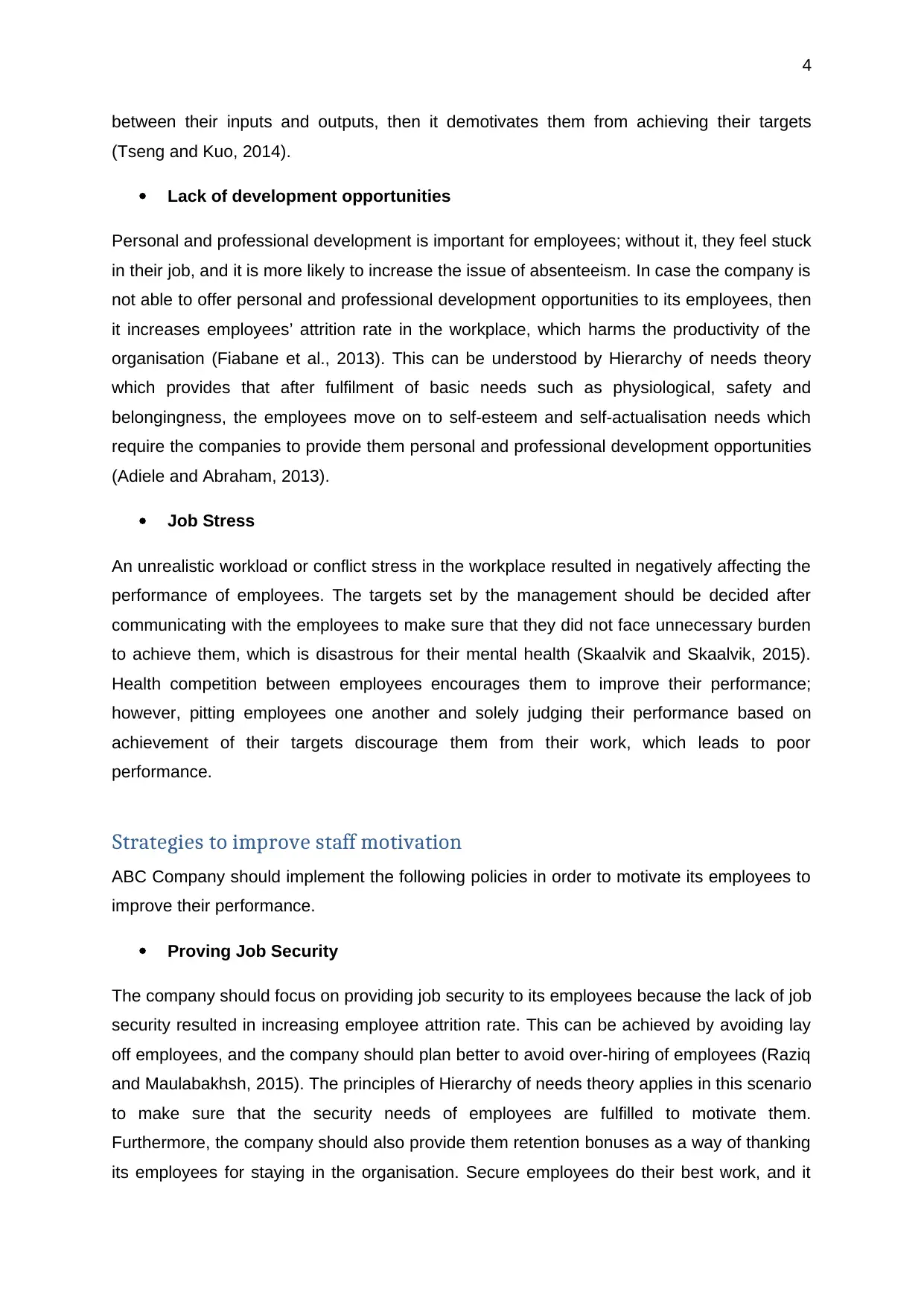
4
between their inputs and outputs, then it demotivates them from achieving their targets
(Tseng and Kuo, 2014).
Lack of development opportunities
Personal and professional development is important for employees; without it, they feel stuck
in their job, and it is more likely to increase the issue of absenteeism. In case the company is
not able to offer personal and professional development opportunities to its employees, then
it increases employees’ attrition rate in the workplace, which harms the productivity of the
organisation (Fiabane et al., 2013). This can be understood by Hierarchy of needs theory
which provides that after fulfilment of basic needs such as physiological, safety and
belongingness, the employees move on to self-esteem and self-actualisation needs which
require the companies to provide them personal and professional development opportunities
(Adiele and Abraham, 2013).
Job Stress
An unrealistic workload or conflict stress in the workplace resulted in negatively affecting the
performance of employees. The targets set by the management should be decided after
communicating with the employees to make sure that they did not face unnecessary burden
to achieve them, which is disastrous for their mental health (Skaalvik and Skaalvik, 2015).
Health competition between employees encourages them to improve their performance;
however, pitting employees one another and solely judging their performance based on
achievement of their targets discourage them from their work, which leads to poor
performance.
Strategies to improve staff motivation
ABC Company should implement the following policies in order to motivate its employees to
improve their performance.
Proving Job Security
The company should focus on providing job security to its employees because the lack of job
security resulted in increasing employee attrition rate. This can be achieved by avoiding lay
off employees, and the company should plan better to avoid over-hiring of employees (Raziq
and Maulabakhsh, 2015). The principles of Hierarchy of needs theory applies in this scenario
to make sure that the security needs of employees are fulfilled to motivate them.
Furthermore, the company should also provide them retention bonuses as a way of thanking
its employees for staying in the organisation. Secure employees do their best work, and it
between their inputs and outputs, then it demotivates them from achieving their targets
(Tseng and Kuo, 2014).
Lack of development opportunities
Personal and professional development is important for employees; without it, they feel stuck
in their job, and it is more likely to increase the issue of absenteeism. In case the company is
not able to offer personal and professional development opportunities to its employees, then
it increases employees’ attrition rate in the workplace, which harms the productivity of the
organisation (Fiabane et al., 2013). This can be understood by Hierarchy of needs theory
which provides that after fulfilment of basic needs such as physiological, safety and
belongingness, the employees move on to self-esteem and self-actualisation needs which
require the companies to provide them personal and professional development opportunities
(Adiele and Abraham, 2013).
Job Stress
An unrealistic workload or conflict stress in the workplace resulted in negatively affecting the
performance of employees. The targets set by the management should be decided after
communicating with the employees to make sure that they did not face unnecessary burden
to achieve them, which is disastrous for their mental health (Skaalvik and Skaalvik, 2015).
Health competition between employees encourages them to improve their performance;
however, pitting employees one another and solely judging their performance based on
achievement of their targets discourage them from their work, which leads to poor
performance.
Strategies to improve staff motivation
ABC Company should implement the following policies in order to motivate its employees to
improve their performance.
Proving Job Security
The company should focus on providing job security to its employees because the lack of job
security resulted in increasing employee attrition rate. This can be achieved by avoiding lay
off employees, and the company should plan better to avoid over-hiring of employees (Raziq
and Maulabakhsh, 2015). The principles of Hierarchy of needs theory applies in this scenario
to make sure that the security needs of employees are fulfilled to motivate them.
Furthermore, the company should also provide them retention bonuses as a way of thanking
its employees for staying in the organisation. Secure employees do their best work, and it
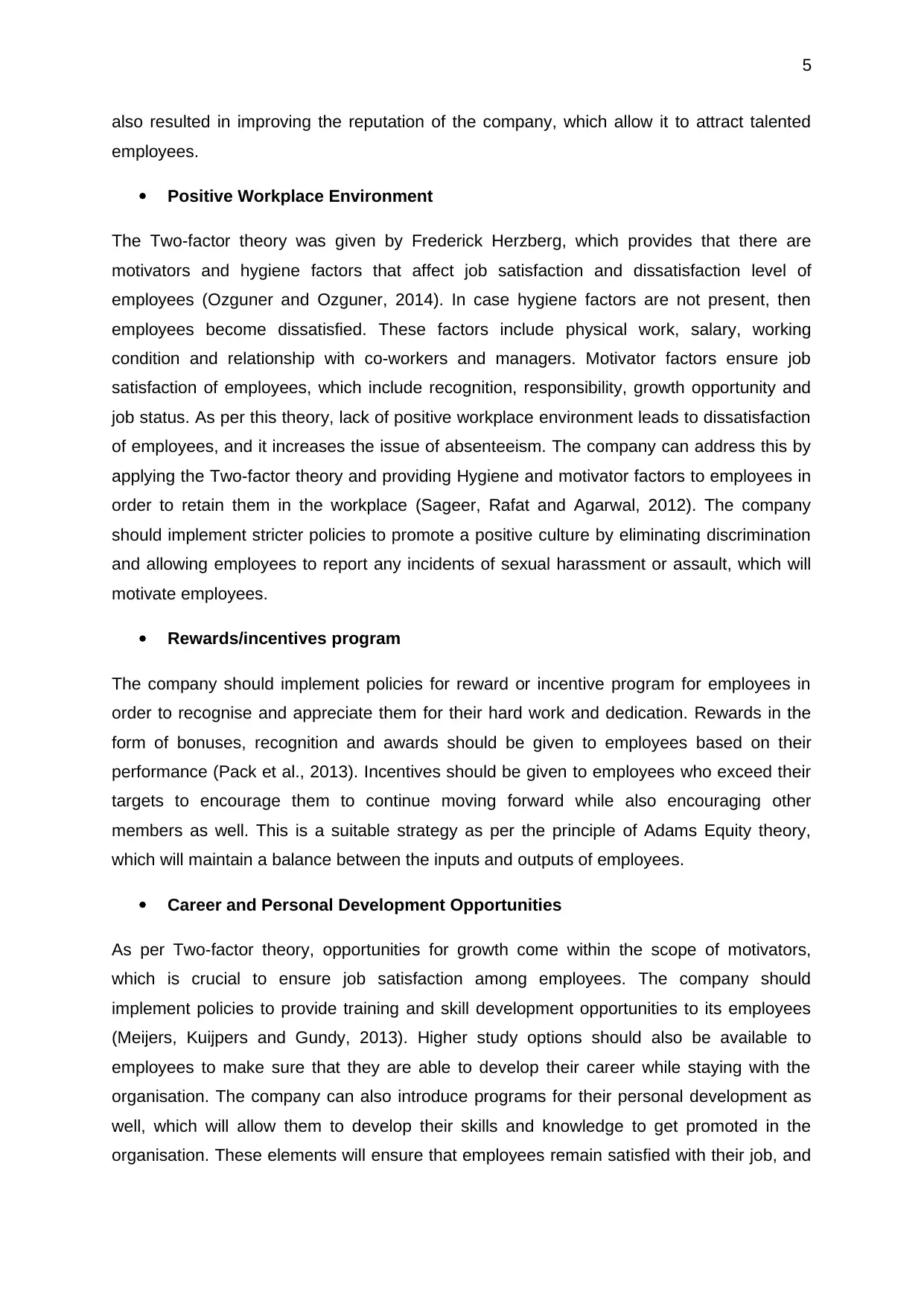
5
also resulted in improving the reputation of the company, which allow it to attract talented
employees.
Positive Workplace Environment
The Two-factor theory was given by Frederick Herzberg, which provides that there are
motivators and hygiene factors that affect job satisfaction and dissatisfaction level of
employees (Ozguner and Ozguner, 2014). In case hygiene factors are not present, then
employees become dissatisfied. These factors include physical work, salary, working
condition and relationship with co-workers and managers. Motivator factors ensure job
satisfaction of employees, which include recognition, responsibility, growth opportunity and
job status. As per this theory, lack of positive workplace environment leads to dissatisfaction
of employees, and it increases the issue of absenteeism. The company can address this by
applying the Two-factor theory and providing Hygiene and motivator factors to employees in
order to retain them in the workplace (Sageer, Rafat and Agarwal, 2012). The company
should implement stricter policies to promote a positive culture by eliminating discrimination
and allowing employees to report any incidents of sexual harassment or assault, which will
motivate employees.
Rewards/incentives program
The company should implement policies for reward or incentive program for employees in
order to recognise and appreciate them for their hard work and dedication. Rewards in the
form of bonuses, recognition and awards should be given to employees based on their
performance (Pack et al., 2013). Incentives should be given to employees who exceed their
targets to encourage them to continue moving forward while also encouraging other
members as well. This is a suitable strategy as per the principle of Adams Equity theory,
which will maintain a balance between the inputs and outputs of employees.
Career and Personal Development Opportunities
As per Two-factor theory, opportunities for growth come within the scope of motivators,
which is crucial to ensure job satisfaction among employees. The company should
implement policies to provide training and skill development opportunities to its employees
(Meijers, Kuijpers and Gundy, 2013). Higher study options should also be available to
employees to make sure that they are able to develop their career while staying with the
organisation. The company can also introduce programs for their personal development as
well, which will allow them to develop their skills and knowledge to get promoted in the
organisation. These elements will ensure that employees remain satisfied with their job, and
also resulted in improving the reputation of the company, which allow it to attract talented
employees.
Positive Workplace Environment
The Two-factor theory was given by Frederick Herzberg, which provides that there are
motivators and hygiene factors that affect job satisfaction and dissatisfaction level of
employees (Ozguner and Ozguner, 2014). In case hygiene factors are not present, then
employees become dissatisfied. These factors include physical work, salary, working
condition and relationship with co-workers and managers. Motivator factors ensure job
satisfaction of employees, which include recognition, responsibility, growth opportunity and
job status. As per this theory, lack of positive workplace environment leads to dissatisfaction
of employees, and it increases the issue of absenteeism. The company can address this by
applying the Two-factor theory and providing Hygiene and motivator factors to employees in
order to retain them in the workplace (Sageer, Rafat and Agarwal, 2012). The company
should implement stricter policies to promote a positive culture by eliminating discrimination
and allowing employees to report any incidents of sexual harassment or assault, which will
motivate employees.
Rewards/incentives program
The company should implement policies for reward or incentive program for employees in
order to recognise and appreciate them for their hard work and dedication. Rewards in the
form of bonuses, recognition and awards should be given to employees based on their
performance (Pack et al., 2013). Incentives should be given to employees who exceed their
targets to encourage them to continue moving forward while also encouraging other
members as well. This is a suitable strategy as per the principle of Adams Equity theory,
which will maintain a balance between the inputs and outputs of employees.
Career and Personal Development Opportunities
As per Two-factor theory, opportunities for growth come within the scope of motivators,
which is crucial to ensure job satisfaction among employees. The company should
implement policies to provide training and skill development opportunities to its employees
(Meijers, Kuijpers and Gundy, 2013). Higher study options should also be available to
employees to make sure that they are able to develop their career while staying with the
organisation. The company can also introduce programs for their personal development as
well, which will allow them to develop their skills and knowledge to get promoted in the
organisation. These elements will ensure that employees remain satisfied with their job, and
⊘ This is a preview!⊘
Do you want full access?
Subscribe today to unlock all pages.

Trusted by 1+ million students worldwide
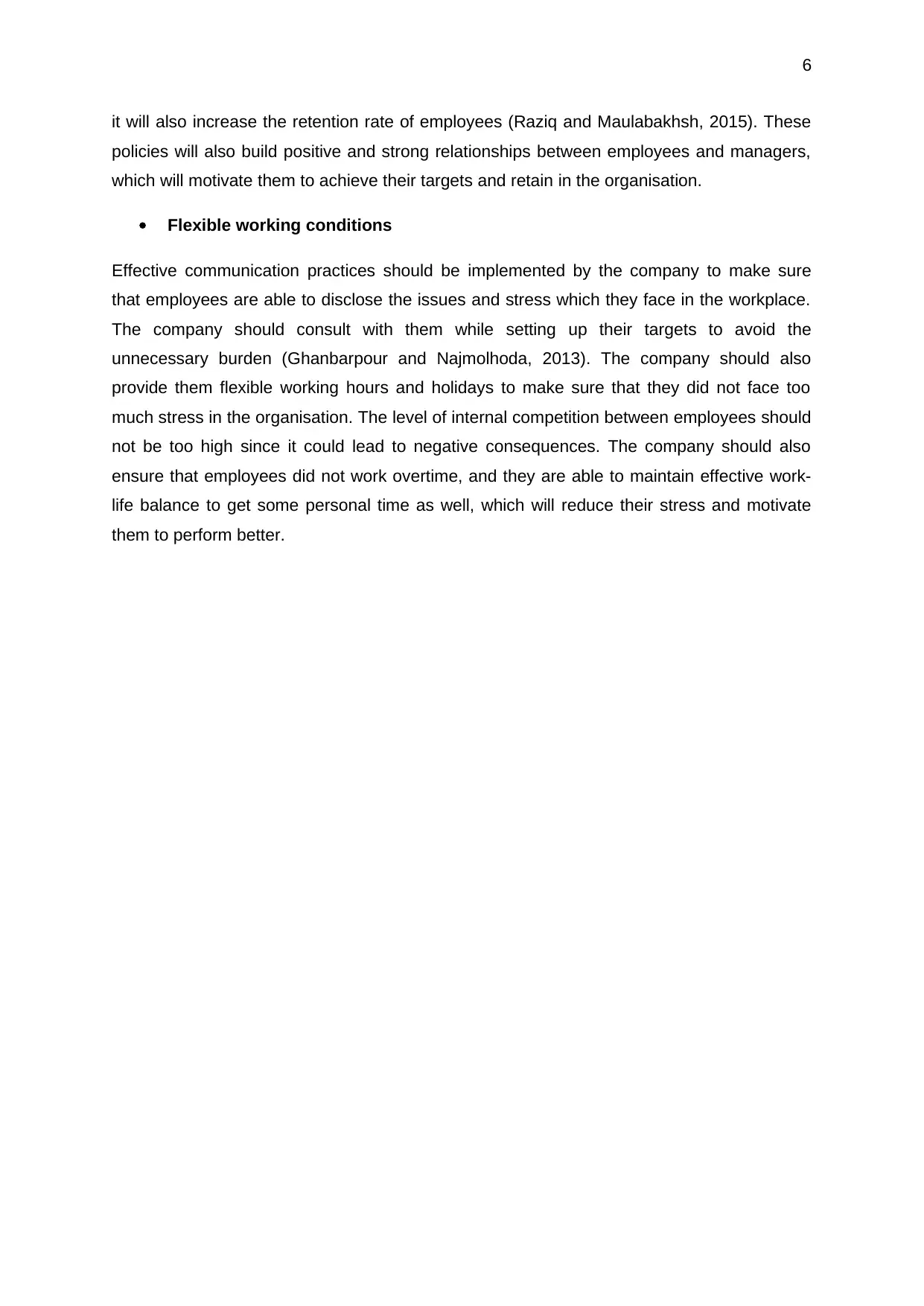
6
it will also increase the retention rate of employees (Raziq and Maulabakhsh, 2015). These
policies will also build positive and strong relationships between employees and managers,
which will motivate them to achieve their targets and retain in the organisation.
Flexible working conditions
Effective communication practices should be implemented by the company to make sure
that employees are able to disclose the issues and stress which they face in the workplace.
The company should consult with them while setting up their targets to avoid the
unnecessary burden (Ghanbarpour and Najmolhoda, 2013). The company should also
provide them flexible working hours and holidays to make sure that they did not face too
much stress in the organisation. The level of internal competition between employees should
not be too high since it could lead to negative consequences. The company should also
ensure that employees did not work overtime, and they are able to maintain effective work-
life balance to get some personal time as well, which will reduce their stress and motivate
them to perform better.
it will also increase the retention rate of employees (Raziq and Maulabakhsh, 2015). These
policies will also build positive and strong relationships between employees and managers,
which will motivate them to achieve their targets and retain in the organisation.
Flexible working conditions
Effective communication practices should be implemented by the company to make sure
that employees are able to disclose the issues and stress which they face in the workplace.
The company should consult with them while setting up their targets to avoid the
unnecessary burden (Ghanbarpour and Najmolhoda, 2013). The company should also
provide them flexible working hours and holidays to make sure that they did not face too
much stress in the organisation. The level of internal competition between employees should
not be too high since it could lead to negative consequences. The company should also
ensure that employees did not work overtime, and they are able to maintain effective work-
life balance to get some personal time as well, which will reduce their stress and motivate
them to perform better.
Paraphrase This Document
Need a fresh take? Get an instant paraphrase of this document with our AI Paraphraser
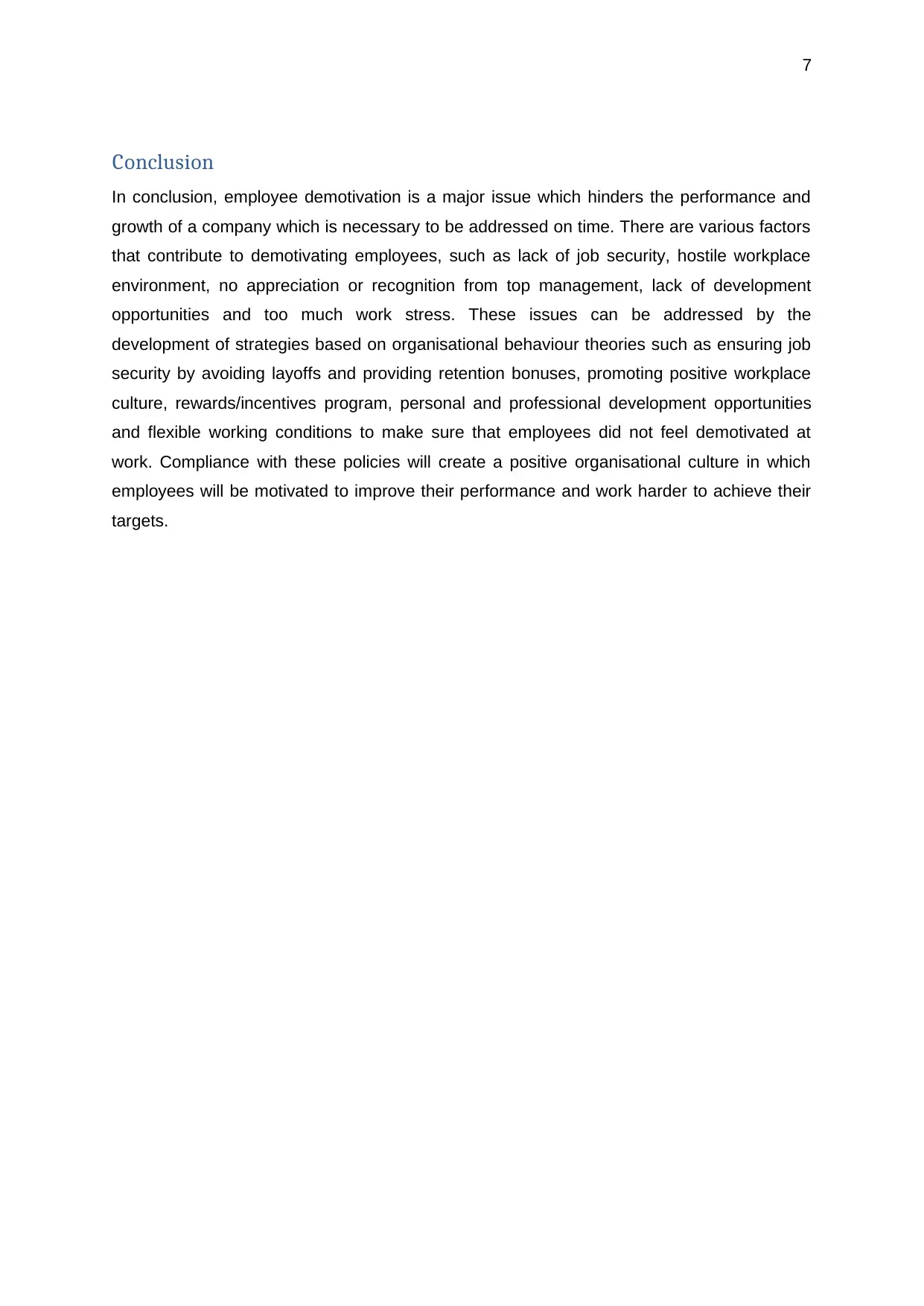
7
Conclusion
In conclusion, employee demotivation is a major issue which hinders the performance and
growth of a company which is necessary to be addressed on time. There are various factors
that contribute to demotivating employees, such as lack of job security, hostile workplace
environment, no appreciation or recognition from top management, lack of development
opportunities and too much work stress. These issues can be addressed by the
development of strategies based on organisational behaviour theories such as ensuring job
security by avoiding layoffs and providing retention bonuses, promoting positive workplace
culture, rewards/incentives program, personal and professional development opportunities
and flexible working conditions to make sure that employees did not feel demotivated at
work. Compliance with these policies will create a positive organisational culture in which
employees will be motivated to improve their performance and work harder to achieve their
targets.
Conclusion
In conclusion, employee demotivation is a major issue which hinders the performance and
growth of a company which is necessary to be addressed on time. There are various factors
that contribute to demotivating employees, such as lack of job security, hostile workplace
environment, no appreciation or recognition from top management, lack of development
opportunities and too much work stress. These issues can be addressed by the
development of strategies based on organisational behaviour theories such as ensuring job
security by avoiding layoffs and providing retention bonuses, promoting positive workplace
culture, rewards/incentives program, personal and professional development opportunities
and flexible working conditions to make sure that employees did not feel demotivated at
work. Compliance with these policies will create a positive organisational culture in which
employees will be motivated to improve their performance and work harder to achieve their
targets.
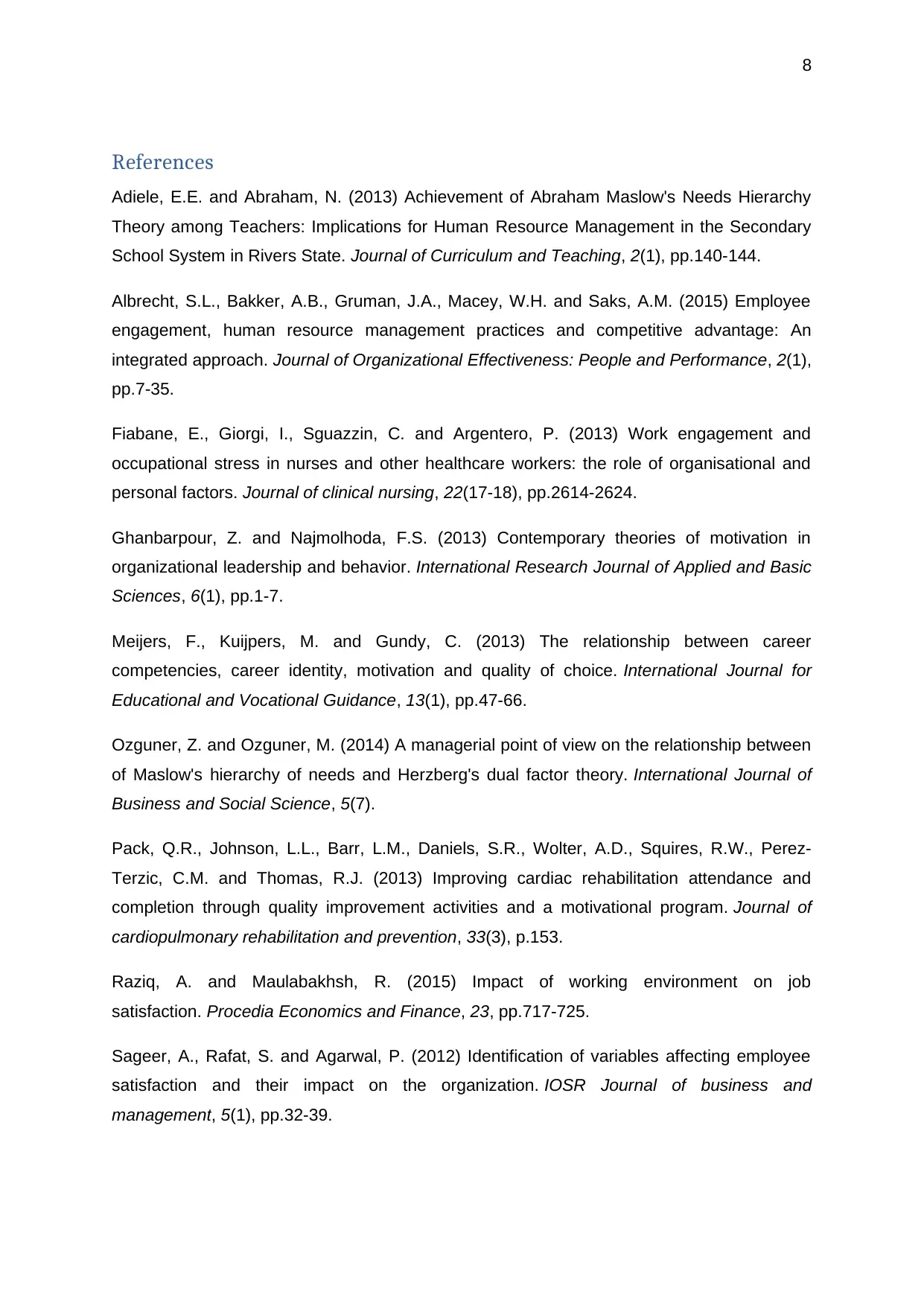
8
References
Adiele, E.E. and Abraham, N. (2013) Achievement of Abraham Maslow's Needs Hierarchy
Theory among Teachers: Implications for Human Resource Management in the Secondary
School System in Rivers State. Journal of Curriculum and Teaching, 2(1), pp.140-144.
Albrecht, S.L., Bakker, A.B., Gruman, J.A., Macey, W.H. and Saks, A.M. (2015) Employee
engagement, human resource management practices and competitive advantage: An
integrated approach. Journal of Organizational Effectiveness: People and Performance, 2(1),
pp.7-35.
Fiabane, E., Giorgi, I., Sguazzin, C. and Argentero, P. (2013) Work engagement and
occupational stress in nurses and other healthcare workers: the role of organisational and
personal factors. Journal of clinical nursing, 22(17-18), pp.2614-2624.
Ghanbarpour, Z. and Najmolhoda, F.S. (2013) Contemporary theories of motivation in
organizational leadership and behavior. International Research Journal of Applied and Basic
Sciences, 6(1), pp.1-7.
Meijers, F., Kuijpers, M. and Gundy, C. (2013) The relationship between career
competencies, career identity, motivation and quality of choice. International Journal for
Educational and Vocational Guidance, 13(1), pp.47-66.
Ozguner, Z. and Ozguner, M. (2014) A managerial point of view on the relationship between
of Maslow's hierarchy of needs and Herzberg's dual factor theory. International Journal of
Business and Social Science, 5(7).
Pack, Q.R., Johnson, L.L., Barr, L.M., Daniels, S.R., Wolter, A.D., Squires, R.W., Perez-
Terzic, C.M. and Thomas, R.J. (2013) Improving cardiac rehabilitation attendance and
completion through quality improvement activities and a motivational program. Journal of
cardiopulmonary rehabilitation and prevention, 33(3), p.153.
Raziq, A. and Maulabakhsh, R. (2015) Impact of working environment on job
satisfaction. Procedia Economics and Finance, 23, pp.717-725.
Sageer, A., Rafat, S. and Agarwal, P. (2012) Identification of variables affecting employee
satisfaction and their impact on the organization. IOSR Journal of business and
management, 5(1), pp.32-39.
References
Adiele, E.E. and Abraham, N. (2013) Achievement of Abraham Maslow's Needs Hierarchy
Theory among Teachers: Implications for Human Resource Management in the Secondary
School System in Rivers State. Journal of Curriculum and Teaching, 2(1), pp.140-144.
Albrecht, S.L., Bakker, A.B., Gruman, J.A., Macey, W.H. and Saks, A.M. (2015) Employee
engagement, human resource management practices and competitive advantage: An
integrated approach. Journal of Organizational Effectiveness: People and Performance, 2(1),
pp.7-35.
Fiabane, E., Giorgi, I., Sguazzin, C. and Argentero, P. (2013) Work engagement and
occupational stress in nurses and other healthcare workers: the role of organisational and
personal factors. Journal of clinical nursing, 22(17-18), pp.2614-2624.
Ghanbarpour, Z. and Najmolhoda, F.S. (2013) Contemporary theories of motivation in
organizational leadership and behavior. International Research Journal of Applied and Basic
Sciences, 6(1), pp.1-7.
Meijers, F., Kuijpers, M. and Gundy, C. (2013) The relationship between career
competencies, career identity, motivation and quality of choice. International Journal for
Educational and Vocational Guidance, 13(1), pp.47-66.
Ozguner, Z. and Ozguner, M. (2014) A managerial point of view on the relationship between
of Maslow's hierarchy of needs and Herzberg's dual factor theory. International Journal of
Business and Social Science, 5(7).
Pack, Q.R., Johnson, L.L., Barr, L.M., Daniels, S.R., Wolter, A.D., Squires, R.W., Perez-
Terzic, C.M. and Thomas, R.J. (2013) Improving cardiac rehabilitation attendance and
completion through quality improvement activities and a motivational program. Journal of
cardiopulmonary rehabilitation and prevention, 33(3), p.153.
Raziq, A. and Maulabakhsh, R. (2015) Impact of working environment on job
satisfaction. Procedia Economics and Finance, 23, pp.717-725.
Sageer, A., Rafat, S. and Agarwal, P. (2012) Identification of variables affecting employee
satisfaction and their impact on the organization. IOSR Journal of business and
management, 5(1), pp.32-39.
⊘ This is a preview!⊘
Do you want full access?
Subscribe today to unlock all pages.

Trusted by 1+ million students worldwide
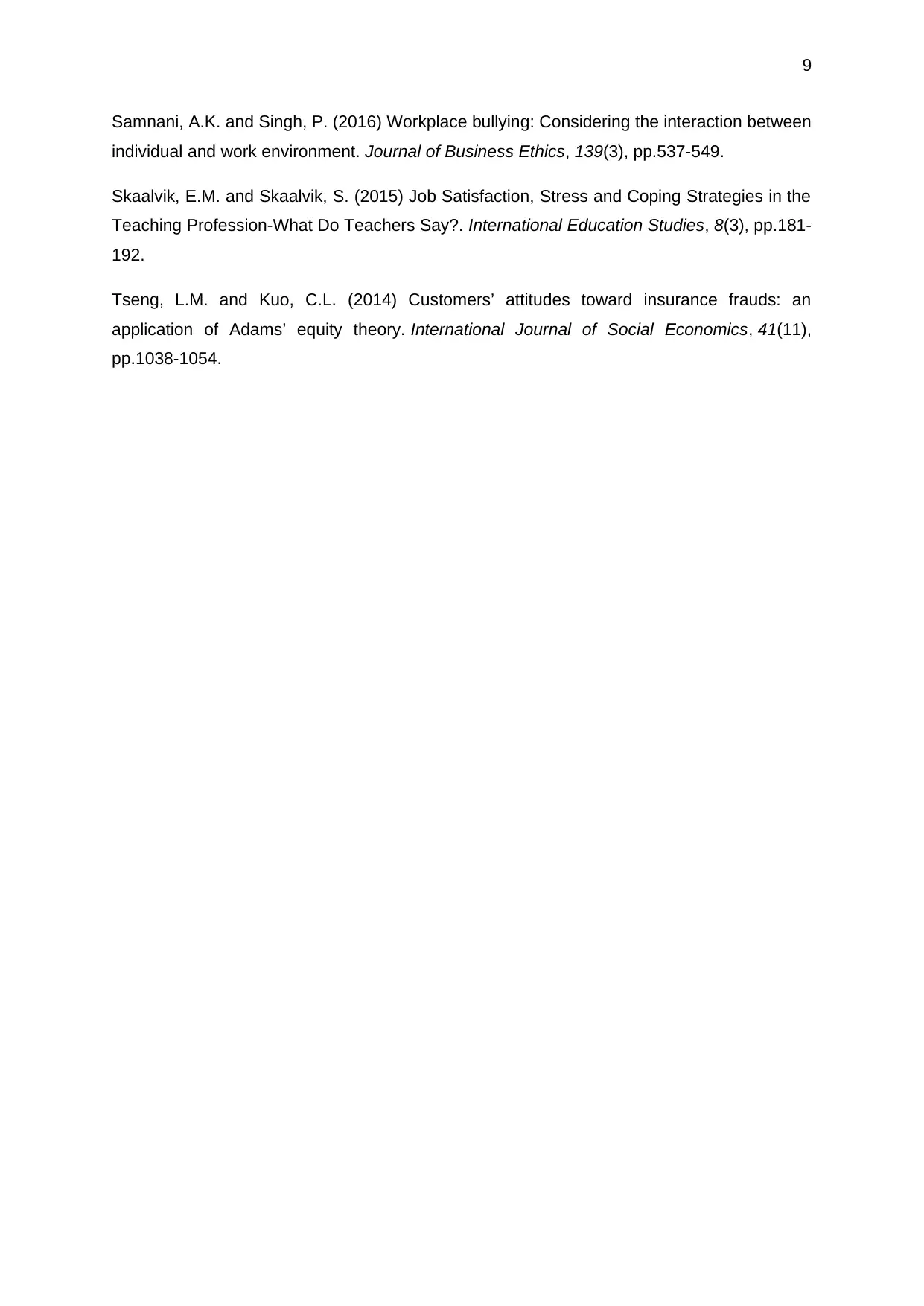
9
Samnani, A.K. and Singh, P. (2016) Workplace bullying: Considering the interaction between
individual and work environment. Journal of Business Ethics, 139(3), pp.537-549.
Skaalvik, E.M. and Skaalvik, S. (2015) Job Satisfaction, Stress and Coping Strategies in the
Teaching Profession-What Do Teachers Say?. International Education Studies, 8(3), pp.181-
192.
Tseng, L.M. and Kuo, C.L. (2014) Customers’ attitudes toward insurance frauds: an
application of Adams’ equity theory. International Journal of Social Economics, 41(11),
pp.1038-1054.
Samnani, A.K. and Singh, P. (2016) Workplace bullying: Considering the interaction between
individual and work environment. Journal of Business Ethics, 139(3), pp.537-549.
Skaalvik, E.M. and Skaalvik, S. (2015) Job Satisfaction, Stress and Coping Strategies in the
Teaching Profession-What Do Teachers Say?. International Education Studies, 8(3), pp.181-
192.
Tseng, L.M. and Kuo, C.L. (2014) Customers’ attitudes toward insurance frauds: an
application of Adams’ equity theory. International Journal of Social Economics, 41(11),
pp.1038-1054.
1 out of 10
Related Documents
Your All-in-One AI-Powered Toolkit for Academic Success.
+13062052269
info@desklib.com
Available 24*7 on WhatsApp / Email
![[object Object]](/_next/static/media/star-bottom.7253800d.svg)
Unlock your academic potential
Copyright © 2020–2025 A2Z Services. All Rights Reserved. Developed and managed by ZUCOL.



